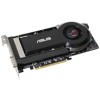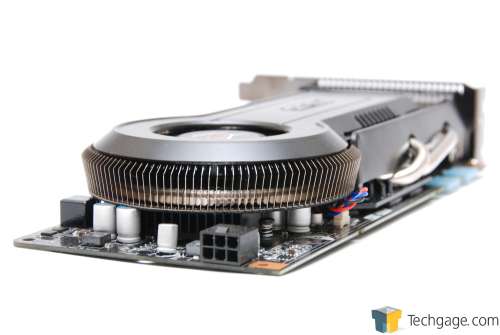- Qualcomm Launches Snapdragon 4 Gen 2 Mobile Platform
- AMD Launches Ryzen PRO 7000 Series Mobile & Desktop Platform
- Intel Launches Sleek Single-Slot Arc Pro A60 Workstation Graphics Card
- NVIDIA Announces Latest Ada Lovelace Additions: GeForce RTX 4060 Ti & RTX 4060
- Maxon Redshift With AMD Radeon GPU Rendering Support Now Available
ASUS GeForce EN9800GT Matrix

Picking out a new graphics card is easier to do now than ever, as there seems to be a model to cover every single price-range, and not just from one single GPU manufacturer, either. Today’s card is one that represents the ~$125 price spot and is designed as a step-up from the 9600 GT, with ASUS applying their usual TLC to help add even more appeal.
Page 11 – Power Consumption, Final Thoughts
In the age where anyone can appreciate good power efficiency, it’s almost upsetting to see how much wattage any graphics card manages to pull from our walls. Even the lowest-end models don’t seem too impressive when compared to the power efficiency of a CPU, but that’s how it is, at least right now. It’s interesting to see how different GPUs compare in this regard, as some might perform better than others, but use less power, like we normally see with a shift to a smaller process node.
To help see what kind of wattage a given GPU eats on average, we use a Kill-A-Watt that’s plugged into a power bar that’s in turn plugged into one of the wall sockets, with the test system plugged directly into that. The monitor and other components are plugged into the other socket and is not connected to the Kill-A-Watt. For our system specifications, please refer to our methodology page.
Like our temperature testing, the computer is boot up and left idle for ten minutes, at which point the current wattage reading is recorded. To test for full load wattage, 3DMark Vantage is again loaded up and run at the “Extreme” setting. The space flight test is used here, with the result being recorded during a specific sequence during that run where it seems to stress the GPU the most.

With default clocks, the power consumption scales with the 9600 GT, and falls right behind the HD 4850. The included iTracker software allows you to go into a power-saving mode that will decrease the power even further when the GPU isn’t being used for 3D graphics. With stock speeds, our ‘idle’ wattage was 183W, while with the power-saving enabled, it was 165W.
Final Thoughts
From a value standpoint, the 9800 GT is a great card. Most such cards hover around the $100 area, which makes it appropriate since many 9600 GT’s can be had for around $80. The performance differences between the two aren’t major as you’d expect given the majorly increased number of cores, but it’s a good boost nonetheless.
Beyond the 9800 GT would come the HD 4850, by an additional $30, and for an average of $20 more than that, we get the even faster 9800 GTX+. There are so many models on the market right now, that the FPS/$ ratio is very good, and no matter what card you pick up, you’re generally going to get what you pay for.
In the case of this particular card, I’d have to say it’s not worth the cost-of-entry. It currently retails for $149.99, and for almost the same price ($160), you could score a much faster 9800 GTX+. If you happen to take advantage of mail-in rebates, then this card will end up costing you $129.99, which makes it a little bit easier to stomach. But again, there are many more 9800 GT’s available that go even lower. Some, as I mentioned, even go as low as $100.
What ASUS’ card does offer is extremely low noise when at idle. It’s so quiet… you’d swear it was using a passive cooler. Still, given the cost, it almost would have been nice to see an actual passive cooler, because at least then, this card would have a very important redeeming feature.
All in all, the 9800 GT is a good card for the money, and delivers a great value. But for even better value, this particular model should be avoided. ASUS themselves offer other 9800 GT’s that cost less than this (one is $109.99 after MIR at NewEgg, currently), which aside from the cooler, has almost identical specs to this one.
- Pros
- Great cooler design.
- Three-phase power solution.
- QUIET when at idle.
- Great performance for the price.
- Allows power-saving mode for a decrease of 20W.
- Cons
- This particular model is too expensive.
- iTracker software works, but is far too clunky.
Discuss this article in our forums!
Have a comment you wish to make on this article? Recommendations? Criticism? Feel free to head over to our related thread and put your words to our virtual paper! There is no requirement to register in order to respond to these threads, but it sure doesn’t hurt!
Support our efforts! With ad revenue at an all-time low for written websites, we're relying more than ever on reader support to help us continue putting so much effort into this type of content. You can support us by becoming a Patron, or by using our Amazon shopping affiliate links listed through our articles. Thanks for your support!






